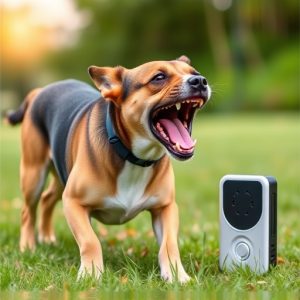Dog Repellent Device Compliance Testing: Ensuring Safety and Efficacy
Dog repellent devices, leveraging ultrasound, static electricity, and scent markers, safely discoura…….
Dog repellent devices, leveraging ultrasound, static electricity, and scent markers, safely discourage unwanted canine behaviors without causing harm. These tools undergo stringent compliance testing to meet safety standards, ensuring they are effective yet humane solutions for dog owners. Dog Repellent Device Compliance Testing is critical in verifying reliability, mitigating risks, and fostering trust among consumers, with evaluations focusing on shock intensity, sound levels, deployment scenarios, and adherence to local regulations, ultimately guaranteeing product quality, safety, and efficacy.
“Discover the revolutionary world of humane dog deterrent electronic devices, designed to protect your space without causing harm. This article explores the inner workings of these innovative solutions, shedding light on their effectiveness and safety.
We delve into the significance of Dog Repellent Device Compliance Testing, ensuring products meet industry standards. From understanding device functionality to comprehensive testing procedures, this guide is essential for anyone seeking effective yet safe dog deterrents. Uncover the key to harmonious coexistence with our four-legged friends.”
- Understanding Dog Repellent Devices and Their Functionality
- The Importance of Compliance Testing for Dog Repellent Devices
- Ensuring Safety and Efficacy: A Comprehensive Guide to Testing Procedures
Understanding Dog Repellent Devices and Their Functionality
Dog repellent devices, also known as electronic pet deterrents, are designed to discourage unwanted canine behavior without causing harm. These tools emit specific sounds, vibrations, or odors that alert dogs to potential dangers, prompting them to avoid certain areas. The primary function is to train and guide dogs, addressing issues like barking, roaming, or aggression.
These devices operate on a range of principles, including ultrasound, static electricity, and scent markers. Compliance testing ensures these products meet safety standards and effectively deter dogs without causing physical injury. Regular assessments guarantee that dog repellent devices emit safe sound levels and activate only when necessary, respecting both animal welfare and human comfort.
The Importance of Compliance Testing for Dog Repellent Devices
The effectiveness and safety of a dog repellent device are pivotal considerations, especially as these products aim to protect both pets and people without causing harm. This is where Dog Repellent Device Compliance Testing becomes indispensable. Independent testing ensures that devices meet established safety standards, confirming their reliability and mitigating potential risks. It verifies the product’s ability to deter dogs humanely, without resorting to harmful stimuli that could cause physical or psychological distress.
Compliance testing involves rigorous assessments of factors like shock intensity, sound levels, and deployment scenarios, ensuring these devices operate within safe parameters. By subjecting them to standardized tests, manufacturers can guarantee their products are not only efficient but also humane. This process is crucial in fostering consumer trust, as it provides assurance that the dog repellent device will function as intended while adhering to ethical standards for animal welfare.
Ensuring Safety and Efficacy: A Comprehensive Guide to Testing Procedures
Ensuring Safety and Efficacy: A Comprehensive Guide to Testing Procedures
When it comes to dog repellent devices, safety and efficacy are paramount. Compliance testing is a critical step in ensuring that these electronic tools meet industry standards and deliver on their promises. Rigorous testing procedures involve evaluating the device’s effectiveness in deterring dogs while minimizing harm or discomfort to both animals and humans. This includes assessing factors like shock intensity, frequency, and duration, as well as the device’s overall performance under various environmental conditions.
A comprehensive guide to Dog Repellent Device Compliance Testing should cover a wide range of scenarios, from lab simulations to field trials. It must include tests for safety features, such as automatic shutdown mechanisms and user-friendly controls, ensuring that the device can be safely operated by anyone. Moreover, it should evaluate the device’s reliability over time, its impact on non-target species, and its compliance with local regulations. By adhering to these testing procedures, manufacturers can guarantee the quality, safety, and efficacy of their dog repellent devices.
In conclusion, a humane dog deterrent electronic device must undergo rigorous Dog Repellent Device Compliance Testing to ensure safety and efficacy. By adhering to comprehensive testing procedures, we can guarantee these devices effectively deter canine behavior without causing harm. This ensures peace of mind for pet owners while fostering safe, harmonious interactions between dogs and their environments.


